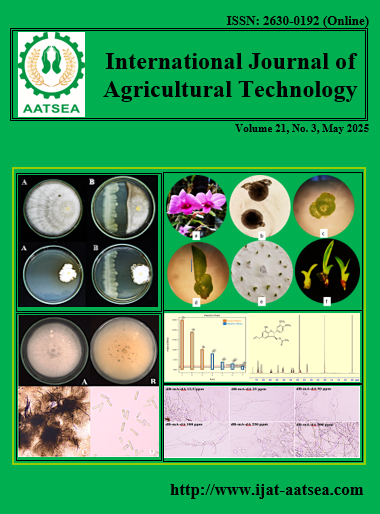Semen evaluation of Boer breeder bucks as influenced by lysine supplementation.
Main Article Content
Abstract
Artificial insemination (AI) is widely used biotechnology tool applied to improve reproduction and genetics in livestock. The viability of the sperm cells is the most important factor to ensure successful insemination which can be achieved through proper nutrition management. The effect of amino acid supplementation, particularly additional of lysine in the diet of breeder bucks is studied. The production performance and quality of sperm cells produced by semen donors without supplementation (T1) is differentiated with donors receiving 1.75% lysine or low rate (T2), 2.45% or moderate rate (T3), and 3.15% or high rate of supplementation (T4) within two periods: Period 1 (Days 1-21) and Period 2 (Days 22 and onwards). The results showed that with lysine supplementation regardless of rate, animals are heavier than the animals that were not supplemented (p<0.05). Lysine supplementation positively affected on animal’s libido in terms of period consumed and the number of mountings before a successful ejaculation (p<0.05). The volume of semen increased (p<0.001); while sperm cell concentration, motility, fast progressive, slow progressive, circle and local motility rates were not significantly affected; however, positive effect on rate of immotile (p<0.01) and velocity (p<0.05) was observed. Considering all parameters, Treatment 2 lysine supplementation resulted to improve animal production and higher viability of sperm cells in both fresh and frozen-thawed state. Thus, 1.75% of lysine is recommended for inclusion to daily dietary concentrate ration.
Article Details

This work is licensed under a Creative Commons Attribution-NonCommercial-NoDerivatives 4.0 International License.
References
Benatta, M., Kettache, R., Buchholz, N. and Trinchieri, A. (2020). The impact of nutritionand lifestyle on male fertility. Archivio Italiano di Urologia e Andrologia, 92:121-131.
Dong, H. J., Wu, D. Xu, X. Y., Li, Q., Fang, Z. F. Che, L. Q. Wu, Q. M. and Lin, Y. (2016). Effect of dietary supplementation with amino acids on boar sperm quality and fertility. Animal Reproduction Science, 9:172:182.
European Food Safety Authority Journal (2015). Scientific Opinion on the safety and efficacy of L-lysine for all animal species. Wiley Online Library. Retrieved from https://www.cabidigitallibrary.org/doi/pdf/10.5555/20153289355
Foote, R. H. (2002). The history of artificial insemination: Selected notes and notables. Journal of Animal Science, 80:1-10.
Greenwood, R. H. and Titgemeyer, E. C. (2000). Limiting amino acids for growing Holstein steers limit-fed soybean hull-based diets. Journal of Animal Science, 78:1997-2004.
Guan, Y., Malecki, I., Hawken, P. and Linden, M. (2014). Under-nutrition reduces spermatogenic efficiency and sperm velocity, and increases sperm DNA damage in sexually mature male sheep. Animal Reproduction Science, 149:163-172.
Hernandez, J. and Gifford, C. (2013). Role of reproductive biotechnologies in enhancing food security and sustainability. Animal Frontier, 2013:3-6.
Hsin-Tai, H., Chun-Yun, W., Tsung-Hsien, H. and Chean-Ping. W. (2021). Effects of different methionine to lysine ratios in starter feed on growth, blood, digestive traits, and carcass traits in goat kids. Journal of Applied Animal Research, 49:264-269.
Klemesrud M. J., Klopfenstein T. J., Stock R. A., Lewis A. J. and Herold D. W. (2000). Effect of dietary concentration of metabolizable lysine on finishing cattle performance. Journal of Animal Science, 78:1060-1066.
Liao, S. F., Wang, T. and Regmi, N. (2015). Lysine nutrition in swine and the related monogastric animals: muscle protein biosynthesis and beyond. Springerplus, 4:147-152.
Martin, G. B., Blache, D., Miller, W. and Vercoe, E. (2010). Interactions between nutrition and reproduction in the management of the mature male ruminant. Animal, 4:1214-1226.
Nayga, J. N., Balbin, A. M., Gaffud, O. M., Gumiran, D. D. and Dela Cruz. P. M. (2011). Development of semen extenders and artificial insemination delivery systems for goat in Region 2. (Project Completion Report). Department of Science and Technology- Philippine Council for Agriculture, Aquatic and Natural Sciences Research and Development, Philippines.
Orden, E. A., Del Rosario, N. A. and Orden, M. E. M. (2018). Feed and Feeding Management. Farmer Livestock School on Goat Enterprise Management Manual. Department of Science and Technology- Philippine Council for Agriculture, Aquatic and Natural Sciences Research and Development, Philippines.
Ren, B., Cheng, X., Wu, D., Xu, S. Y., Che, L. Q., Fang, Z. F., Lv, G., Dong, H. J. and Lin. Y. (2015). Effect of different amino acid patterns on semen quality of boars fed with low-protein diets. Animal Reproduction Science, 161:96-103.
Ritagliati, C., Luque, G. M. and Stival, C. (2018). Lysine acetylation modulates mouse sperm capacitation. Scientific Reports, 8:133-139.
Rurangwa, E., Kime, D. E., Ollevier, F. and Nash, J. P. (2004). The measurement of sperm motility and factors affecting sperm quality in cultured fish. Aquaculture, 234:1-28.
Santiago-Moreno, J., Bernal, B., Perez-Cerezales, S., Castano, C., Toledano-Diaz, A., Esteso, M., Guiterrez-Adan, A., Lopez-Sebastian, A., Gil, M., Woelders, H. and Blesbois, E. (2019). Seminal plasma amino acod profile of different breeds of chicken: role of seminal plasma on sperm cryoresistance. Plos.One, 14:1-19.
Srivastava, S., Kaur, R., Bawa, S. R., Phadke, R. S., Bain, H. K., Sehgal, S. and Govil, G. (1993). Maturation, capacitation, and metabolism of goat spermatozoa using magnetic resonance methods. Andrologia, 25:223-227.
Staub, C. and Johnson, L. (2018). Review: Spermatogenesis in bull. Animal, 12:1123-1135.
Sun, G., Jiang, M., Zhou, T., Guo, Y., Cui, Y., Guo, X. and Sha, J. (2014). Insights into the lysine acetylproteome of human sperm. Journal of Proteomics, 23:199-211.
Wu, G. (2009). Amino acids: metabolism, functions, and nutrition. Amino Acids, 37: 1-17.


